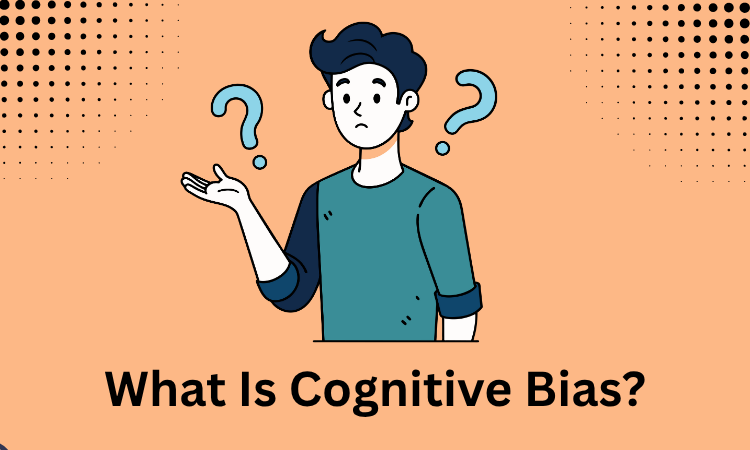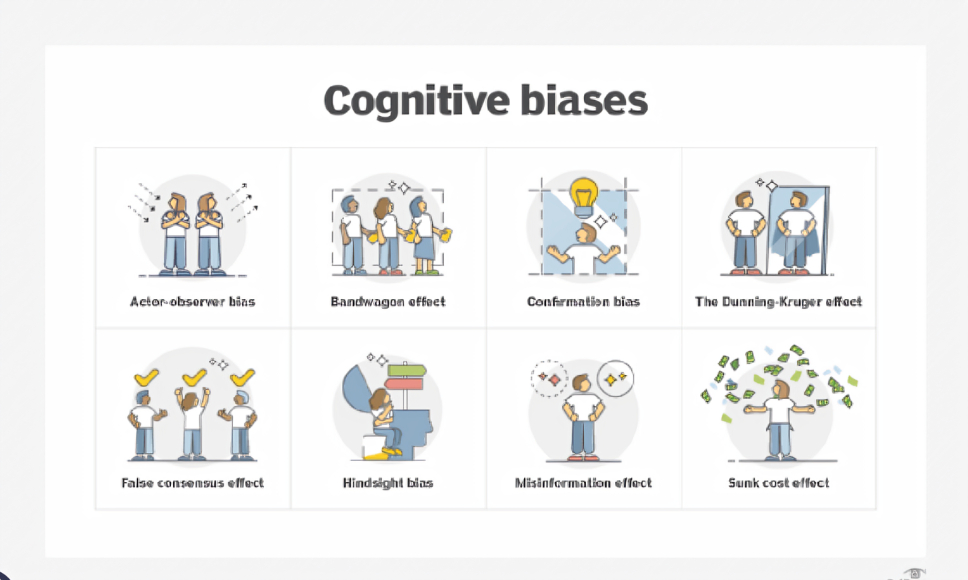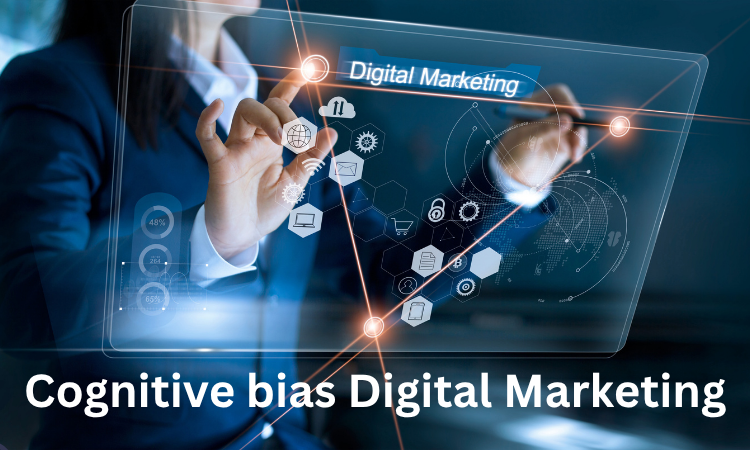Digital marketing is not only about tools or strategies. It also depends on how people think, feel, and make choices.
This is where cognitive bias in digital marketing becomes important. It is a mental shortcut that influences decisions, often without people noticing.
When marketers understand these shortcuts, they can build stronger campaigns that connect with users.
Actions like clicking, signing up, or purchasing often come from how a message is framed.
This approach is not meant to mislead anyone. It focuses on how the mind works and creates better user experiences.
When used with care, it helps make marketing more thoughtful and human.
What Is Cognitive Bias?
Cognitive bias is a mental shortcut the brain uses to make quick decisions. These shortcuts are not always logical, but they help avoid overthinking.
In daily life, they save time, though they sometimes cause judgment errors. Cognitive bias in digital marketing matters because people often respond to how something is shown, not just the facts.
If a product feels urgent or popular, it usually draws more attention. These reactions come from how the brain is wired.
Marketers who understand this can build stronger campaigns that connect with users, using digital marketing strategies.
This is not about misleading anyone. It is about aligning messages with how people already think.
When used with care, this approach improves communication and makes campaigns more effective without being pushy.

Why Do Marketers Use Cognitive Bias?
Marketers do not rely on bias to deceive. They use it to connect. People make decisions emotionally before they think logically.
That is where cognitive bias helps. It acts as a bridge between emotion and action. Marketers use it to shape messages in ways that resonate more with the audience.
For example, presenting something as “limited” makes it feel more valuable. Showing others using a product builds comfort and trust.
These are simple mental triggers, but they are powerful. They work because they reflect how the human brain already works.
Cognitive bias helps marketing messages feel familiar, urgent, or trustworthy, depending on how it is used.
Common Types of Cognitive Bias in Digital Marketing
Anchoring Bias
People usually judge things based on the first piece of information they see.
In digital marketing, showing a high original price before a discount can make the offer look better.
This first number becomes the anchor, which influences how users feel about the deal or product afterward.
Scarcity Bias
When something seems limited, people feel a stronger urge to take action. Messages like “Only 3 items left” or “Offer ends in 2 hours” trigger a fear of missing out.
Scarcity bias works well in digital marketing to create urgency and push users to act without delaying decisions.
Social Proof
People often follow what others are doing. Positive reviews, testimonials, and user ratings help build trust.
When users see that many others have already made a choice, they feel safer doing the same.
Social proof in digital marketing increases confidence and reduces hesitation before taking action.
Loss Aversion
People prefer avoiding losses more than gaining something new. In digital marketing, this bias is used with phrases like “Do not miss this deal” or “Ending soon.”
These create a sense of potential loss. Users then act faster to avoid missing out on what seems valuable or helpful.
Framing Effect
The way information is presented shapes how people understand it. Saying “90% fat-free” feels better than “10% fat,” even though both mean the same.
In digital marketing, framing helps highlight the benefits more clearly. Proper wording influences emotions and leads users toward making faster, more positive choices.

Impact of Cognitive Bias on Consumer Behavior
Consumer behavior is rarely as logical as it seems. People think they make smart, reasoned choices, but cognitive bias often plays a quiet role in shaping decisions.
A person may buy a product not because it is the best, but because it was shown as “most popular.”
That is social proof in action. Another person might feel pressure to buy something because it was labeled “only 2 left.” That is scarcity bias at work.
These triggers change how users feel and act, sometimes without them noticing.
The result is that behavior can be nudged in ways that feel natural but are driven by unseen mental shortcuts.
In digital marketing, this understanding helps brands design smarter journeys. But it also raises questions.
Are users truly choosing, or just reacting? Recognizing this impact helps both marketers and consumers.
It brings awareness to behavior and encourages more thoughtful interaction on both sides of the screen.
Ethical Concerns Around Cognitive Bias Use
While cognitive bias can make marketing more effective, it can also cross into uncomfortable territory.
There is a line between influence and manipulation. When users are pushed too hard using fear, urgency, or pressure, the trust starts to fade.
Ethical marketing means using bias to support, not trick. Brands should always ask: is this helpful to the user? For example, reminding someone that an offer ends soon is fair.
But inventing fake urgency crosses a line. Transparency matters. When people feel misled, they lose confidence in the brand.
Long-term trust is more valuable than short-term clicks. Ethical use of bias respects the customer’s ability to choose. It guides gently, not forcefully.
The goal should be to improve understanding and experience, not to force action.
Marketers who use bias responsibly not only protect their brand’s reputation but also contribute to a healthier marketing environment where honesty and clarity come first.

Using Bias in a Positive Way for Marketing
Cognitive bias is not just a trick. It can be used in ways that genuinely help users.
For instance, marketers can use anchoring to guide people toward better-value choices instead of the most expensive ones.
Scarcity can be used to help people decide quickly when it really matters, like in flash donation campaigns.
Confirmation bias can be used to support people’s healthy or productive beliefs. Even social proof can be a tool for building communities around shared values.
These are positive applications. The aim is not just to sell, but to guide users toward decisions they will not regret.
Marketing has power. Using that power responsibly can help people take smarter actions, support good causes, or avoid decision fatigue. Bias is part of how people think.
When marketers understand that, they can create helpful, kind, and more supportive experiences that serve both the brand and the audience in a lasting way.
Why Choosing BrandOut Makes Digital Marketing Easier?
BrandOut makes digital marketing easier by giving you the right tools and support to stay focused. It helps you avoid guesswork, plan better, and connect with your audience in a natural way.
From building campaigns to improving results, BrandOut works with you to keep things simple, clear, and more effective at every step.
Wrapping Up
It is simply how the brain works, not a mistake in thinking. In digital marketing, it affects how people react to messages and make decisions. Marketers who understand this can create better campaigns.
But this knowledge must be used with care. Bias should guide people, not pressure them. Brands that stay honest build stronger trust.
When used thoughtfully, cognitive bias helps marketing feel more human and personal.
As people become more aware, honest and respectful use of bias becomes more important. In the end, good marketing builds real relationships.
Commonly asked questions:
What is bias in digital marketing?
Bias in digital marketing means using natural thinking habits to shape how people respond to content or ads.
These mental shortcuts help users decide quickly, but they are not always logical. Marketers use this to guide actions, like clicks or purchases.
For example, showing a countdown timer on a sale uses urgency bias to push faster decisions, helping campaigns get better results without forcing people.
What is an example of cognitive bias in shopping?
An everyday example is scarcity bias. When a website shows “Only 1 left in stock,” people feel pressured to buy quickly.
This bias creates a sense of urgency that pushes customers to act fast. Even if they were unsure before, the idea of missing out makes the product seem more valuable.
This tactic works well in digital marketing to increase conversions and drive quick buying decisions.
Is brand loyalty a cognitive bias?
Brand loyalty can be linked to confirmation bias. People tend to stick with what they already believe is good.
They ignore flaws in their favorite brand and focus only on the positives. Even if another brand is better or cheaper, they stay loyal because their mind filters information to support past choices.
This mental habit keeps people returning to the same brand without comparing new options fairly.
What is an example of the cognitive effect of media?
A strong example is the framing effect. Media can change how people feel by changing the way information is presented.
Saying “90% success rate” sounds more positive than “10% failure rate,” even if the fact is the same.
This small change in words has a big impact on how people react. Digital marketers and content creators use this to influence opinions, emotions, and consumer decisions.




